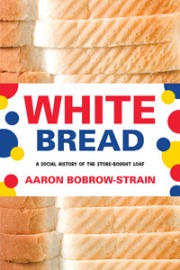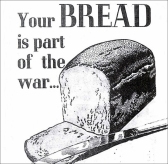Who would’ve thought a book about white bread, of all things, would be a page-turner?
I read White Bread: A Social History of the Store-Bought Loaf by Aaron Bobrow-Strain, and I couldn’t put it down.
The author covers topics such as how factory-made bread became an effort to better society; how white bread was considered the first “super-food” and was marketed as patriotic; and how food reformers worked to show white bread was a symbol of all that was wrong with America.
It was fascinating to me to read research and history related to immigration, home economics, food supply, and baking.
In the early 1900s, as factory-made bread was becoming more mainstream and “acceptable”, a Pennsylvania journalist explained in 1914, that a woman’s “time and effort squandered on pointless home baking was responsible for most domestic misery. Women should concern themselves with things they could do relatively well–looking beautiful, raising healthy children, and efficiently administering a modern household.” What? Isn’t that crazy?
There was a campaign to pump up industrial production of bread and, in favor of women, a new vision of domesticity – that a “good housewife” was a professional manager working to maximize her family’s health. The U of Chicago home economics department chair predicted that women would be judged, not by their skill at baking good bread, but by their skill at buying it. Consumers making the decisions – and all driven by bread. (p. 63)
The book also paints a historical picture of early health crusaders who were trying to paint the picture of white bread not being good for health. For example, from a 1929 radio show: “The whiter your bread, the quicker you’re dead.” (p. 73) The doctor who said this (Dr. Hutchinson) also wasn’t doing any favors for whole wheat bread–he said he nutrients came “in an utterly indigestible for – bran and husks.” (p. 97)
I could go on and on, but I’ll leave you with this fun fact–in 1954, Americans were eating white bread at all three meals, totaling consumption of 8.6 billion loaves a year! Most people ate 3-7 slices of white bread a day – and 33% of the population ate more than 8 slices a day! (p. 122-123) This statistic cut across all income levels and ages but not gender–women ate the least as many diets at the time ‘forbid’ the consumption of bread.
Do you make homemade bread? Favorite bread? Did you learn something new today?
Reading this book did make me hungry for bread–I have a recipe for english muffin bread that I’ve been wanting to try–maybe that will be this weekend’s baking project.



wow! this book sounds really interesting. i might have to check it out. 🙂 that’s shocking that people ate 3-7 slices of white bread per day in the 1950’s. that kind of grosses me out!
It was considered good fuel! Things have certainly changed.
Woooowwww 3-7 slices per day! Amazing. Thanks for sharing, Nicole, some of these esoteric books can be really fascinating reads.
I feel like I’m over-doing it if I have 2/day!
I am OBSESSED with homemade bread. It’s probably one of my favorite things!
It’s always worth the effort!
I LOVE all things bread. When I was in college I used to buy the frozen bread dough loaves. They made my dorm room smell heavenly as it baked but was much easier than buying all the ingredients and mixing/kneading. Pity the carbs in bread are killer for weight loss. 🙂
There’s a guy at my office building who has a bread machine at work!
Whoa – wish we could do something like that here at work. But I think we’d make everyone hungry in the office. 🙂
I love boks like this! I will have to check it out.
My nutrition professor mentioned that phrase and dove a little bit into the history, but it sounds like a fascinating book! I don’t make home made bread because yeast=don’t rise for me=rock hard bread. I actually don’t eat much bread because I can’t eat a whole loaf before it goes bad. I usually end up freezing it if I do. Funny thing is that I’ve never been a fan of white bread, even when I was a kid. Probably because it just fell apart anytime I tried to put something on or in it!
I remember trying to spread pb on white bread and ending up with just a giant hole in the bread!
Wow, those stats are astounding! I love food history books like that–need to add this one to my list. 🙂
This book sounds great! Growing up I always ate bread from the Russian store so I think it was more grain country cooked type. Bread has always been a great staple in my diet but I don’t think I ate 8 slices a day! Insane!
Wow! Interesting information on bread and society. Sad that the food manufacturers targeted women…and still do 😦
I much prefer “time and effort squandered on pointless home baking” than concerning myself with “looking beautiful”.
Bread is a huge part of the Dutch diet, but I haven’t fully adapted to this new food culture. Breakfast here can be a few slices of white bread with butter and hagelslag (chocolate sprinkles). Yum! And lunch is bread with cheese & deli meats. The corner bakery sells half loaves of all types; Helps reduce how much we consume. Though, I’m fond of sliced white, toasted, topped with fig preserves (a la my cajun grandma)…and served with a cold glass of milk.
During my visits to NL I always enjoyed the hot, fresh bread at the corner bakeries. A particular favorite was a grain bread filled with raisins and nuts!